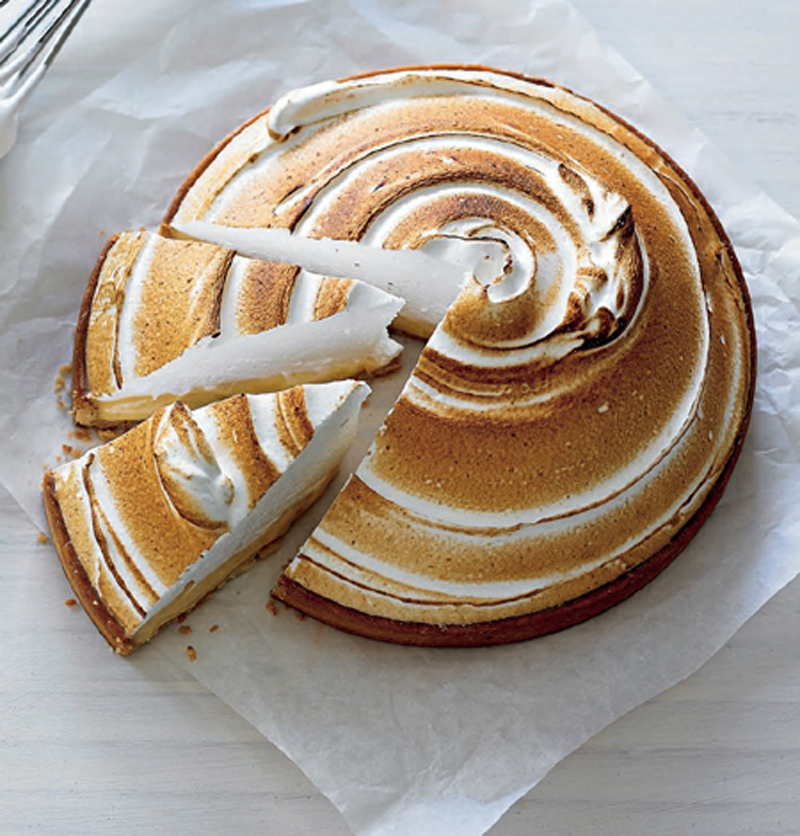 Tarts filled with lemon have been around for centuries, but it wasn’t until the nineteenth century that a Swiss baker had the idea of topping the pie with meringue. This very clever idea balances the tartness of the lemons with sweetness of the meringue, while the crunchy pastry base adds a textural layer. In this recipe I have added basil, bringing intonations of pepper, mint and anise, which softens the sweetness of the meringue and helps to refine the slightly harsh flavour of the lemon curd.
Tarts filled with lemon have been around for centuries, but it wasn’t until the nineteenth century that a Swiss baker had the idea of topping the pie with meringue. This very clever idea balances the tartness of the lemons with sweetness of the meringue, while the crunchy pastry base adds a textural layer. In this recipe I have added basil, bringing intonations of pepper, mint and anise, which softens the sweetness of the meringue and helps to refine the slightly harsh flavour of the lemon curd.
Ingredients
- 10½ oz (300 g) Pâte Sablée
- 7 oz (200 g) egg whites (about 6–7)
- 10½ oz (300 g) pure icing (confectioners’) sugar, sifted
Curd
- 3½ oz (100 g) basil leaves
- ice cubes
- 43/4 fl oz (140 ml) lemon juice
- 1 vanilla bean, halved lengthways
- 63/4 oz (190 g) caster (superfine) sugar
- 1 tablespoon maize cornflour (cornstarch)
- 3 eggs
- 1 egg yolk
- 8½ oz (240 g) cold unsalted butter, chopped
How to Make It
- To make the curd, bring a saucepan of water to the boil, add the basil and return to the boil. Remove the basil with a slotted spoon and quickly place on a bed of ice. When the leaves have cooled, place in a blender and blend into a fine purée. Transfer to a bowl, add the lemon juice and vanilla bean, then cover and refrigerate overnight, to allow the flavours to develop.
- The following day, put the sugar and cornflour in a bowl and whisk until smooth. Add the eggs and egg yolk and combine well. Remove the vanilla bean from the lemon and basil mixture, then use the back of a knife to scrape along the length of each cut side to remove the seeds. Add the seeds to the egg mixture and combine well. Discard the vanilla beans. Add the lemon and basil mixture to the egg mixture, then, using a stick blender, process until smooth and well combined.
- Strain the mixture through a fine sieve into a heatproof bowl and place over a bain-marie (see tips). Using a hand-held whisk, whisk the mixture until thick and opaque (about 70°C/160°F). At this temperature the egg yolk is cooked and the cornflour has fully gelatinised. Remove the bowl from the heat, add the butter, then use a stick blender to blend until smooth and creamy. Cover the surface with plastic wrap, leave to cool slightly, then refrigerate.
- You will need a 25 cm (10 in) tart ring or tart tin with a removable base. Roll out the pastry on a lightly floured work surface until 5 mm (¼ in) thick. Line the base and side of the tin with the pastry, then refrigerate for 30 minutes.
- Preheat the oven to 180°C (350°F). Line the pastry shell with foil, making sure the side of the shell is covered, then fill to the top with uncooked rice or baking beads. Blind bake for 20 minutes, or until the base is golden. Remove the rice and foil and set aside until cool.
- Fill the tart shell with the cold curd and spread the top with a spatula until smooth. Make sure the curd is cold or your pastry will become soggy and lose its texture. Refrigerate while you make the meringue.
- To make the meringue, use an electric mixer fitted with a whisk attachment to whisk the egg whites on high speed just until stiff peaks begin to form. Do not overwhip them or you will end up with a lumpy texture. Add half the icing sugar, reduce the speed to medium and whisk for 30 seconds, then add the remaining icing sugar and whisk for another 1 minute.
- Using a spatula, spread the meringue generously over the tart. Don’t make the meringue too flat; use the spatula to make small peaks in the meringue. Using a domestic blowtorch, lightly brown the meringue. Alternatively, place the tart under a preheated grill until the tips of the meringue have caramelised. The tart is best served on the day of making. If you like, serve with a coulis of lightly peppered raspberries.
